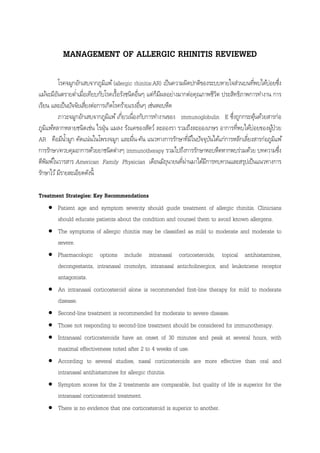
Management of allergic rhinitis reviewed
- 1. MANAGEMENT OF ALLERGIC RHINITIS REVIEWED โรคจมูกอักเสบจากภูมแพ้ (allergic rhinitis:AR) เป็ นความผิดปกติของระบบหายใจส่วนบนทีพบได้บ่อยซึง ิ ่ ่ แม้จะมีอนตรายตํา่ เมือเทียบกับโรคเรื้อรังชนิดอื่นๆ แต่ก็มผลอย่างมากต่อคุณภาพชีวต ประสิทธิภาพการทํางาน การ ั ่ ี ิ เรียน และเป็ นปัจจัยเสียงต่อการเกิดโรคร้ายแรงอืนๆ เช่นหอบหืด ่ ่ ภาวะจมูกอักเสบจากภูมแพ้ เกี่ยวเนื่องกับการทํางานของ immunoglobulin E ซึ่งถูกกระตุนด้วยสารก่อ ิ ้ ภูมแพ้หลากหลายชนิดเช่น ไรฝุ่น แมลง รังแคของสัตว์ ละอองรา รวมถึงละอองเกษร อาการที่พบได้บ่อยของผูป่วย ิ ้ AR คือมีนามูก คัดแน่นในโพรงจมูก และผื่น-คัน แนวทางการรักษาที่มในปัจจุบนได้แก่การหลีกเลียงสารก่อภูมแพ้ ํ้ ี ั ่ ิ การรักษา/ควบคุมอาการด้วยยาชนิดต่างๆ immunotherapy รวมไปถึงการรักษาหอบหืดหากพบร่วมด้วย บทความซึง ่ ตีพมพ์ในวารสาร American Family Physician เดือนมิถนายนทีผ่านมาได้มการทบทวนและสรุปเป็ นแนวทางการ ิ ุ ่ ี รักษาไว้ มีรายละเอียดดังนี้ Treatment Strategies: Key Recommendations • Patient age and symptom severity should guide treatment of allergic rhinitis. Clinicians should educate patients about the condition and counsel them to avoid known allergens. • The symptoms of allergic rhinitis may be classified as mild to moderate and moderate to severe. • Pharmacologic options include intranasal corticosteroids, topical antihistamines, decongestants, intranasal cromolyn, intranasal anticholinergics, and leukotriene receptor antagonists. • An intranasal corticosteroid alone is recommended first-line therapy for mild to moderate disease. • Second-line treatment is recommended for moderate to severe disease. • Those not responding to second-line treatment should be considered for immunotherapy. • Intranasal corticosteroids have an onset of 30 minutes and peak at several hours, with maximal effectiveness noted after 2 to 4 weeks of use. • According to several studies, nasal corticosteroids are more effective than oral and intranasal antihistamines for allergic rhinitis. • Symptom scores for the 2 treatments are comparable, but quality of life is superior for the intranasal corticosteroid treatment. • There is no evidence that one corticosteroid is superior to another.
- 2. • Only budesonide is FDA approved for use in pregnancy with a category B safety rating. • Mometasone is the only corticosteroid that has a delivery device, with recognition from the National Arthritis Foundation for ease of use. • Adverse effects of intranasal corticosteroids include headache, throat irritation, epistaxis, stinging, burning, and dryness. • Data on effect of intranasal corticosteroids on skeletal growth in children are conflicting, and this class of medications carries an FDA warning that long-term use may restrict growth in children. • Oral antihistamines are second-line treatment of allergic rhinitis. Second-generation vs first- generation antihistamines (except for cetirizine) have a better adverse effect profile for sedation. • The second-generation antihistamines stabilize and control some of the nasal and ocular symptoms but have little effect on nasal congestion. • Azelastine and olopatadine are FDA-approved intranasal antihistamines for allergic rhinitis. Onset is 15 minutes with effects up to 4 hours, but their use is limited by adverse effects. • These adverse effects include bitter aftertaste, headache, nasal irritation, epistaxis, and sedation. • Intranasal cromolyn is available over the counter but has an inconvenient dosing schedule of 3 to 4 times daily. • Intranasal anticholinergics such as ipratropium are useful for excessive rhinorrhea but have to be administered 2 to 3 times daily. • Oral montelukast is FDA approved for allergic rhinitis but has been found to be less effective than intranasal corticosteroids and antihistamines and should be used as third-line therapy. • Combination therapy has not been found to be superior to monotherapy with intranasal corticosteroids. • There is insufficient evidence for the efficacy of nonpharmacologic therapies such as acupuncture, probiotics, and herbals; therefore, such alternative treatments cannot be recommended at this time. • Initial treatment of allergic rhinitis should be an intranasal corticosteroid alone, followed by second-line therapies such as oral or intranasal antihistamines.
- 3. • Nasal saline irrigation is beneficial for chronic rhinorrhea and may be used alone or as adjuvant therapy. • Immunotherapy is reserved for moderate or severe persistent allergic rhinitis not responsive to usual treatment; the greatest risk is anaphylaxis. • Recombinant DNA technology allows for allergen-specific vaccines, which can significantly reduce rhinosinusitis symptoms, medication use, and skin sensitivity. • Studies have not found benefit from using mite-proof impermeable mattress and pillow covers. • Interventions without documented evidence include breast-feeding, delayed exposure to solid foods in infancy, and the use of air filtration systems. Clinical Implications • First-line pharmacotherapy for allergic rhinitis consists of intranasal corticosteroids, which are superior to oral or intranasal antihistamines. • Immunotherapy is reserved for moderate to severe allergic rhinitis nonresponsive to pharmacotherapy, and the evidence does not currently support use of alternative therapies for allergic rhinitis. แปลและเรียบเรียง เภสัชกรกิตยศ ยศสมบัติ ิ 21 สิงหาคม 2553 สถานปฏิบตการเภสัชกรรมชุมชน ัิ คณะเภสัชศาสตร์ จุฬาลงกรณ์มหาวิทยาลัย www.osotsala-chula.com ที่มา Am Fam Physician 2010; 81: 1440-1446.
